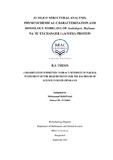In silico structural analysis, physicochemical characterization and homology modeling of Arabidopsis thaliana Na+/H+ exchanger 1 protein

View/Open
Date
2015-09Publisher
BRAC UniversityAuthor
Feisal, Mohammad RafidMetadata
Show full item recordAbstract
Climate changes have detrimental effects on the plants such as an increased susceptibility towards pathogens or ill health leading to food insecurity. This is eminently observed in developing countries such as Bangladesh. Hence, it is of crucial importance to comprehend the mechanisms the plants use to adapt to environmental stresses, such as, salinity. NHX-type antiporter facilitates the exchange of Na+ for H+ across the membranes. It sequesters Na+ form the cytoplasm to vacuoles via the electrochemical H+ gradient generated by two H+- pumps. In Arabidopsis thaliana, NHX1 encodes the vacuolar sodium or proton antiporter and it is identified as a significant salt tolerance determinant that is able to catalyze Na+ accumulation in vacuoles. As such, it is necessary to determine the structure of the protein encoded by the NHX1 gene in Arabidopsis thaliana. This would allow us to establish the regions (e.g. active sites and secondary structural motifs) in the protein that affect the function and protein-protein interaction network in regard to the mechanisms involved in salinity tolerance. The objective of this study is to predict the three-dimensional structure of Arabidopsis thaliana sodium/hydrogen exchanger 1 protein via homology modeling and examine its physicochemical properties using in silico approaches. Biocomputational analyses of the target protein were performed using an array of online bioinformatics tools and databases and the homology model was developed using 3 different softwares (I-TASSER, Phyre2 and Easymodeller) and the best model was selected upon evaluation. In addition, the secondary structural motifs were identified within the model. The results suggested that the EasyModeller model, EM_Model 01, was the best amongst the three. It had the highest stereochemical quality scores and was considered to be the least unusual. The model consisted of α/β/γ topology where a single β-sheet constituted the β-hairpin as observed in the secondary structure schematic and topology diagrams. It was predicted that the presence of the β-hairpin allowed the protein to act as a membrane channel protein to facilitate the exchange of Na+ and H+.
